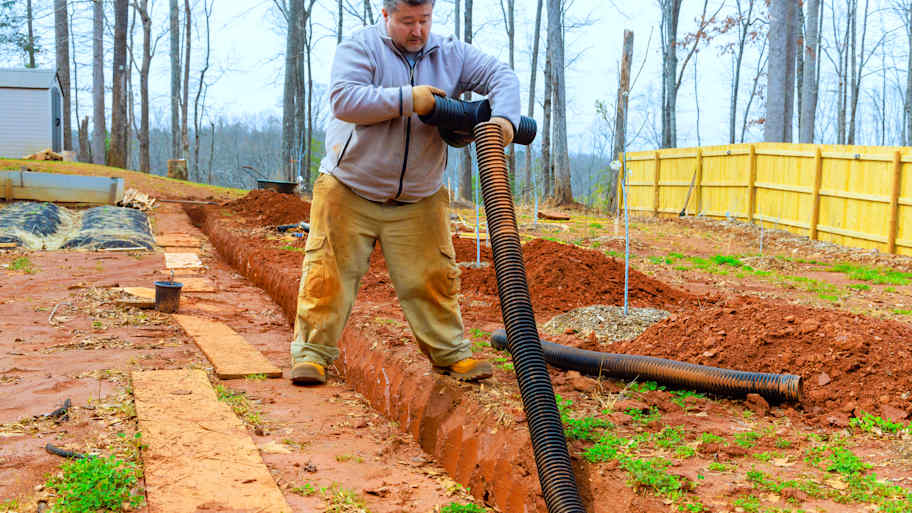
Whether trying to protect it or transport it, raising a house is no small feat. Read on to find out everything you need to know about the cost to raise a house.
Installing weeping tile may bring tears of joy if your basement suffers from flooding


Weeping tile consists of pipes with small holes that reroute water from your foundation, mimicking the look of tears.
Installed 8 to 10 feet deep, weeping tile utilizes hydrostatic pressure to naturally drain water.
Installation can be pretty costly, especially if your home is already built.
You can add a sump pump for extra support in removing water.
No homeowner wants to hear that their basement is flooded. If you’re wondering why water is rising through the floor, the answer could be a sign of excess groundwater or a rising water table—and your basement needs a new drainage system. Weeping tile is a common solution, but it may not be the right choice for every situation.
Keep reading to learn more about a weeping tile drainage system and whether it’s right for your home.
Weeping tile may sound reminiscent of something from the wizarding world, but it’s actually a pretty common type of foundation drainage system. Weeping tile is a perforated pipe installed in a trench around (or inside) a building that looks like it’s crying as it drains water away from the foundation. The water is directed to a different type of water removal system—like a sump pump or storm sewer—to prevent flooding your basement.
When the name was first established, weeping tile drainage systems were made with terracotta, which is a porous material that allows water to seep out. When water drained from the terracotta, it would look like the material was crying and thus the unique name was born. Today, weeping tile is made with plastic pipes that have small holes or slits for the water to drain out of.
Most weeping tile is exterior, because it’s more efficient and effective. However, interior weeping tile is cheaper and can be installed with minimal hassle and at a lower cost.
Exterior weeping tile requires excavation, which can significantly increase your total bill, depending on your existing landscaping and the depth of your basement.

Installation depends on the type of system you have. Let’s go over how a foundation drain installer will install either an exterior or interior weeping tile system.
Here’s how they install an exterior system:
Dig an 8- to 10-foot deep trench around your home’s perimeter.
Pour a few inches of gravel in the trench to help promote drainage and keep the pipes in place.
Place the weeping tile pipe on top of the gravel. Some companies will wrap the pipe in a geotextile fabric sock to help filter debris and prevent clogs.
Backfill the trench with gravel or sand.
Top the area with soil, sod, or concrete, depending on your landscaping preferences.
If you choose an interior system, the trench will be dug inside your home through your concrete foundation. Interior weeping tile will require the installation of a sump pump.
Weeping tiles and French drains share similar functionality but differ in a few key ways. Both are waterproofing methods that help direct water away from a basement to prevent flooding or structural damage.
Weeping tile is best for areas with high water tables or frequent basement flooding. They’re installed much deeper into the ground and use hydrostatic pressure to force water into the pipe for draining. French drains are best for soggy lawns or other surface-level issues, as they simply use gravity to drain water away from a home. They’re more affordable than weeping tile, as they require little to no excavation, but aren’t as effective for basement waterproofing.
Don’t cry when you have foundation drain issues, consider weeping tile instead. Here are some pros and cons of this drainage system to help you decide whether it’s right for your needs.
Reliable waterproofing. Weeping tile is very effective at keeping water out of your basement.
Long lifespan. Weeping tile can last 30+ years if installed and maintained correctly.
Great option for new construction. If you’re building a new home, installing weeping tile is a straightforward and cost-effective process.
Low maintenance. The only real maintenance is keeping debris cleared to prevent clogs.
Expensive. With its extensive trenching, weeping tile can get pricey (especially in already-built homes).
Disruptive installation. The installation can get quite dirty, so be prepared for a messy few weeks during the installation process.
Potential for clogging. Like most drains, weeping tile is susceptible to clogs, especially if there are many trees with extensive root systems.
From average costs to expert advice, get all the answers you need to get your job done.

Whether trying to protect it or transport it, raising a house is no small feat. Read on to find out everything you need to know about the cost to raise a house.

A bowing basement wall needs immediate repair. Learn how much it costs to repair a bowing basement wall and what factors can affect the final price tag.

Staying ahead of foundation problems can save you time and effort. Learn how much foundation inspections cost and what affects how much you’ll pay.

Worried about pier and beam foundation repair costs? Get a better understanding of how to budget by learning about the repair methods available to you.

Find out if you need a permit for your foundation repair before beginning to avoid violation fees, delays in the work, and problems with home resale.

Building code foundation requirements are crucial to build safe structures. Read on to learn how adherence to guidelines ensures stability and resilience.